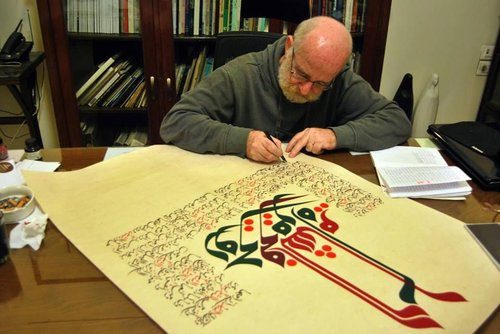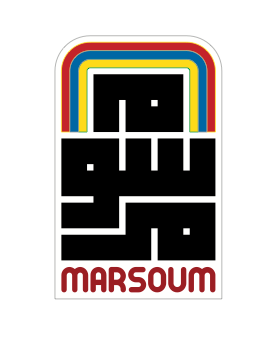
Video & Transcript: An Interview with Mouneer Al-Shaarani in Beirut, 2014
Share
Marsoum Art Collective presents an interview with Master Arabic calligrapher Mouneer Al-Shaarani. Subtitled by marsoum.co (2018)
Full Transcript:
Handwritten Arabic lettering, also known as calligraphy, is an art form in its own right.
We learned about the origins and current state of this art form from one of its masters, Mouneer Al-Shaarani.
“My goal is to bring Arabic calligraphy back to basics,
to honor its origins and keep it true to its essence while applying a contemporary lens to it.”
Over the past few years, Arabic calligraphy has seen a remarkable resurgence, be it through writing, graffiti or as the primary subjects of artworks.
Mouneer Al-Shaarani is a professional calligrapher, designer and published author with a career spanning over 35 years. Al-Shaarani followed his passion for Arabic calligraphy and built upon his talent.
He obtained a degree in graphic design from the Damascus College of Fine Arts in 1977. His name has since become synonymous with contemporary Arabic calligraphy, a discipline in which he has indisputable authority. This is mostly due to the fact that he developed several new techniques and injected new life into an art form that was too stagnant for too long.
Mouneer’s artworks have found homes in the United States and dozens of Arab and European countries.
He has conducted research and published many papers on Arabic calligraphy, as well as Islamic art.
We headed over to Beirut’s very own Art on 56th for an intimate talk with Mouneer Al-Sharaani and an exclusive look at his latest series of artworks.
“At the very beginning, I was always fascinated by illustrations and paintings created by legendary calligraphers and artists that have had a profound impact on the art of calligraphy.”
I was also very committed to seeing artifacts that contained etchings and scriptures that used Arabic calligraphy, whether in books or museums.
And that’s how I learned that the history of calligraphy was inaccurately written from a religious perspective although it borne of something different, for calligraphy was an art form that preceded Islam.
This is why I always find it peculiar that the perception has falsely been that calligraphy and religious scripts are mutually exclusive, but I guess that this is something we’ve inherited from the Ottoman Empire.
I like diving into the roots and researching the origins of different typefaces so that I can understand the theories and foundation of these writings. I also always strive to understand the design philosophy and the aesthetic component of calligraphic typefaces so that I add something new to the equation that still feels natural and authentic.
Based on my readings and research, Arabic calligraphy as an art form was put on ice during the reign of the Ottomans, or rather, locked in a golden cage with sacredness an alibi for stagnancy. So all and any modifications, improvements or innovations to the aesthetic of the art form were considered sacrilege and therefore sadly prohibited during the 6 centuries of Ottoman reign.
This is where I truly felt that it was my calling to shake the status quo up and take this art form out of its dormant state.
And so began my journey; I started by developing certain letters of the alphabet that had been most neglected through the Ottoman years.
I was diligent in selecting letters that had a high aesthetic value where I also saw room for improvement.
This process started gradually with certain typefaces and evolved to what you see in my artworks nowadays, which mostly feature my original typefaces.
My passion for calligraphy started with my passion for visual arts while in elementary school. I was in the third grade and started emulating the titles of the textbooks we used with my pencil.
My school’s principal, who also taught our art classes took note of this and recognized some potential in me. She encouraged me to do an apprenticeship under the guidance of a professional calligrapher, and that’s exactly what I did and how I got set on this path.
My mentor, Badawi Al Dirani, taught me first and foremost the geometric and aesthetic principles of calligraphy that set the foundation for all typefaces. Mastering these has allowed me to embark on my calligraphic journey.
I also learned from him that no letter possesses a final form, for it was him that inspired that notion of transgressing from the traditional forms of lettering that were stagnant for too long.
A good calligrapher is an informed one. He or she must be in touch with the emotions and conditions of those around him or her, as well as those of his or her country, and of humanity in general.
I get great joy from people coming up to me and saying: “We see your artworks and instantly know that they’re yours without having to look at the signature”.
This is something that bring me a great deal of satisfaction as every artist’s ultimate ambition is for him or her to be able to carve out a unique visual identity that sets him or her apart from everyone else.
My life’s work has a purpose that goes far beyond creating beautiful artworks. My is goal to bring Arabic calligraphy back to basics, to honor its origins and keep it true to its essence while applying a contemporary lens to it.
